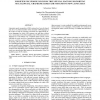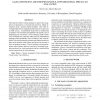123
click to vote
ICASSP
2011
IEEE
14 years 4 months ago
2011
IEEE
We present an algorithm for dereverberation of speech signals for automatic speech recognition (ASR) applications. Often ASR systems are presented with speech that has been record...
101
click to vote
ICASSP
2011
IEEE
14 years 4 months ago
2011
IEEE
Dynamic noise adaptation (DNA) [1, 2] is a model-based technique for improving automatic speech recognition (ASR) performance in noise. DNA has shown promise on artificially mixe...
110
click to vote
LREC
2008
15 years 1 months ago
2008
Texts generated by automatic speech recognition (ASR) systems have some specificities, related to the idiosyncrasies of oral productions or the principles of ASR systems, that mak...
103
click to vote
ISCAS
2006
IEEE
15 years 6 months ago
2006
IEEE
Abstract—We present a silicon neuron with a dynamic, active leak that enables precise spike-timing with respect to a time-varying input signal. Our neuron models the mammalian bu...
ICASSP
2008
IEEE
15 years 6 months ago
2008
IEEE
Automatic speech recognition (ASR) systems have been developed only for a very limited number of the estimated 7,000 languages in the world. In order to avoid the evolvement of a ...
90
Voted
ICASSP
2008
IEEE
15 years 6 months ago
2008
IEEE
There has been little work that attempts to improve the recognition of spontaneous, conversational speech by adding information from a loosely-coupled modality. This study investi...


